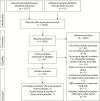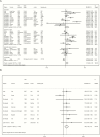Preterm Birth Associated With Group B Streptococcus Maternal Colonization Worldwide: Systematic Review and Meta-analyses
- PMID: 29117329
- PMCID: PMC5850429
- DOI: 10.1093/cid/cix661
Preterm Birth Associated With Group B Streptococcus Maternal Colonization Worldwide: Systematic Review and Meta-analyses
Abstract
Background: Preterm birth complications are the leading cause of deaths among children <5 years of age. Studies have suggested that group B Streptococcus (GBS) maternal rectovaginal colonization during pregnancy may be a risk factor for preterm delivery. This article is the fifth of 11 in a series. We aimed to assess the association between GBS maternal colonization and preterm birth in order to inform estimates of the burden of GBS.
Methods: We conducted systematic literature reviews (PubMed/Medline, Embase, Latin American and Caribbean Health Sciences Literature [LILACS], World Health Organization Library Information System [WHOLIS], and Scopus) and sought unpublished data from investigator groups on the association of preterm birth (<37 weeks' gestation) and maternal GBS colonization (GBS isolation from vaginal, cervical, and/or rectal swabs; with separate subanalysis on GBS bacteriuria). We did meta-analyses to derive pooled estimates of the risk and odds ratios (according to study design), with sensitivity analyses to investigate potential biases.
Results: We identified 45 studies for inclusion. We estimated the risk ratio (RR) for preterm birth with maternal GBS colonization to be 1.21 (95% confidence interval [CI], .99-1.48; P = .061) in cohort and cross-sectional studies, and the odds ratio to be 1.85 (95% CI, 1.24-2.77; P = .003) in case-control studies. Preterm birth was associated with GBS bacteriuria in cohort studies (RR, 1.98 [95% CI, 1.45-2.69]; P < .001).
Conclusions: From this review, there is evidence to suggest that preterm birth is associated with maternal GBS colonization, especially where there is evidence of ascending infection (bacteriuria). Several biases reduce the chance of detecting an effect. Equally, however, results, including evidence for the association, may be due to confounding, which is rarely addressed in studies. Assessment of any effect on preterm delivery should be included in future maternal GBS vaccine trials.
Keywords: bacteriuria; colonization; group B Streptococcus; preterm delivery; preterm labor.
© The Author 2017. Published by Oxford University Press for the Infectious Diseases Society of America.
Figures




References
-
- United Nations Children’s Fund/World Health Organization/World Bank, UN-DESA Population Division. Levels and trends in child mortality—report 2015. New York: United Nations Children’s Fund, 2015.
-
- Liu L, Oza S, Hogan D et al. . Global, regional, and national causes of child mortality in 2000–2013, with projections to inform post-2015 priorities: an updated systematic analysis. Lancet 2015; 385:430–40. - PubMed
Publication types
MeSH terms
Grants and funding
LinkOut - more resources
Full Text Sources
Other Literature Sources
Medical

